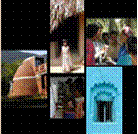|
Sustainable Building Practices -
a stakeholder based evaluation process
The SBP
project was initiated through first regional workshop for the
Western Maharashtra region at Lonavla in December 2001. Through this
session, the stakeholder based assessment methodology was validated
and a prototype Practical Evaluation Tool was developed with a set
of ecological, social and financial indicators. Current developments- urban building practices The
project is now in its second phase (SBP-II) which seeks to refine
and consolidate the PET introduced in the first phase, focusing on
urban building practices. Along with refinement, the other main
objectives of this phase are demonstrating the potential
applications of the tool and setting in place a vibrant SBP network
of practitioners to promote the application of the PET. The project
component in Pune is dealing with the urban context while the
component in Gujarat will address rural habitat issues. In Pune,
core team of building practioners was identified from amongst the
stakeholders of the first workshop to spearhead the activities of
the second phase in consultation with a local advisor. The model
tool developed earlier was applied on actual building projects to
test its suitability and to identify the areas where more
concentrated work needs to be carried out. This period of intensive
core group activity highlighted many crucial areas like
appropriateness of indicators, customization to scale and nature of
building projects. The second regional workshop To
scrutinize and discuss the PET in a larger group of stakeholders
with reference to issues of refinement which emerged so far in the
second phase, a second regional workshop was held in mid May in
Panchgani. The workshop resulted in a clear definition of the PET in
terms of indicators, measurement systems and units of indicators and
the scoring of indicators for a graphical evaluation. Most
discussions which were carried out at the workshop had a reference
to case studies of varied urban buildings like schools, industrial
buildings and bungalows where the tool was applied. This lead to a
revision and redefinition of the indicators relevant to the urban
building scenario. Among the concerns reflected by the indicators
are energy, water management, soil conservation,employment, labour
welfare, cultural activity, traditional building, life cycle cost
and return on investment. Also, a step by step process of measuring
the indicators and according them scores with reference to
pre-defined benchmarks was laid down. Way Forward The community of practitioners, especially designers have committed to applying the PET for evaluating decisions regarding building solutions. The learnings in application will be shared by the network which will further refine the tool. A similar stakeholder based process now be initiated in Gujarat to assess sustainability of building practices in rural areas by evolving a new PET with a new set of indicators. q
|


